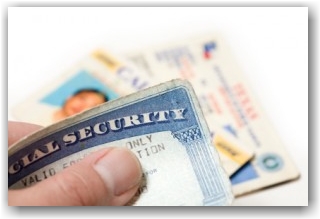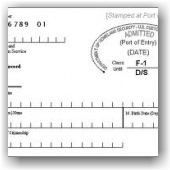Posts Tagged ‘Immigration News’
Sunday, October 6th, 2013
 The Immigration and Nationality Act (“INA”) prohibits employers from discriminating against individuals based on their citizenship or immigration status, or based on their national origin, in the Form I-9 process. It is important for employers to develop, implement and enforce anti-discrimination policies, practices and procedures, and to ensure that all employees conducting Form I-9 verification or E-Verify confirmation understand all program rules. Employers should also provide appropriate and adequate employee education on employer responsibilities and worker rights.
The Immigration and Nationality Act (“INA”) prohibits employers from discriminating against individuals based on their citizenship or immigration status, or based on their national origin, in the Form I-9 process. It is important for employers to develop, implement and enforce anti-discrimination policies, practices and procedures, and to ensure that all employees conducting Form I-9 verification or E-Verify confirmation understand all program rules. Employers should also provide appropriate and adequate employee education on employer responsibilities and worker rights.
To prevent discrimination, employer’s should treat all people equally when
- announcing a job
- taking applications
- performing interviews
- making job offers
- verifying the individual’s authorization to work
- hiring the individual
- terminating the individual’s employment
Employers also must not retaliate against a person who
- files a charge of discrimination with OSC or EEOC
- participates in an investigation or prosecution of a discrimination complaint
- asserts his or her rights or the rights of another person under anti-discrimination laws
The Department of Justice’s Office of Special Counsel for Immigration-Related Unfair Employment Practices (OSC) investigates charges of employment discrimination related to an individual’s citizenship or immigration status or national origin. The Equal Employment Opportunity Commission (EEOC) also investigates employment discrimination based on national origin, in addition to other protected bases. OSC investigates national origin claims against employers with four to 14 employees, and EEOC investigates national origin claims against employers with 15 or more employees.
There has been a high level of enforcement by OSC this year concerning the anti-discrimination provision, with three more cases recently publicized in the last month:
- OSC settled with Texas-based Infinity Group who required non-citizens present specific DHS-issued documents such as green-cards or employment authorization to establish identity and employment authorization while similarly not requesting the same of US citizens. They were fined $53,000, had to pay $35K in back pay to those who were damaged as a result of their practices.
- OSC settled with PA-based Huber Nurseries for engaging in citizenship discrimination by preferring to hire temporary H-2A visa holders over Permanent Residents (green-card holders). Huber has agreed to pay $2,250 in civil penalties to the USA and $59,617 in back pay to the six injured parties, who are former refugees; and
- OSC settled with IBM for violating the anti-discrimination provision for placing online job postings for software developers with a preference for F-1 and H-1B visa holders. IBM has agreed to pay $44,400 in civil penalties to the USA.
So, what’s an employer to do?
Employers must accept all documents that are indicated on the List of Acceptable Documents to complete the I-9 form as long as they appear reasonably genuine on their face and relate to the employee. For example, all individuals who possess a driver’s license and unrestricted Social Security card may present those documents to satisfy Form I-9 requirements. Employers may not request or require potential employees to produce “green cards” or United States citizens who look or sound “foreign” to produce birth certificates. The employee chooses which of the acceptable Form I-9 documents to present. Employers must assure that those charged with the responsibility of I-9 management are trained on I-9 regulations and the anti-discrimination provision of the INA – and they must not
- Demand that an employee show specific documents
- Ask to see employment authorization documents before an individual accepts a job offer
- Refuse to accept a document, or refuse to hire an individual, because a document will expire in the future
- Refuse to accept a receipt that is acceptable for Form I-9 purposes
- Demand a specific document when reverifying that an employee is authorized to work
We recommend that you take some time and read the OSC’s Guide to Fair Employment that can be accessed here, that contains some thought provoking What would you do? scenarios that start on page 6.
Should you have questions or require particular guidance on this topic, please feel free to contact our office.
Tags: Department Of Homeland Security (DHS), E-Verify, Employment Practices, Hiring Practices, I-9 Audits, I-9 management, I-9 Penalties, I-9/E-Verify News, ICE, ICE Fines, Immigration News, INA Anti-Discrimination Provision, Legal Workforce, OSC, SSA
Posted in Department Of Homeland Security (DHS), Employer Compliance, I-9/E-Verify News, ICE, OSC, Social Security, USCIS | Comments Off on I-9/E-Verify: Preventing Discrimination in Hiring Practices
Friday, September 27th, 2013

USCIS has indicated that not all SSA documents referring to the ownership of the SSA account or reflecting an application for a new card, are valid receipts for the I-9 process. So, what constitutes a valid SSA replacement receipt?
The only receipt from SSA that is acceptable under the receipt rule is a receipt that states “This is a receipt to show you applied for a social Security Card and the application was for a lost, stolen or damaged document.” Any other receipt would not be acceptable. Your employee may present a receipt for the application for the replacement of any List A, List B, or List C document. The receipt is valid for 90 days. When it expires, the employee must show you the replacement document for which the receipt was given.
After the receipt expires, you should:
1) Cross out the word “receipt” and any accompanying document number
2) Record the number and other required document information from the actual document presented.
3) Initial and date the change.
You cannot accept a receipt for the I-9 Form for an initial or renewal employment authorization, but can accept a receipt for the application for replacement of a lost, stolen or damaged employment authorization document. You cannot accept receipts if employment will last less than three days.
The Three-Day Business Rule
Q: How does an employer that is operational over the weekend but whose HR office (which is open during regular business hours but closed on weekends) count the 3-business days for I-9 purposes?
A: Employers are required to complete the I-9 Form within 3 business days of the employees first day of work for pay. If the business is operational on the weekends, this counts towards the 3 day timeframe for I-9 completion. Thus, in order to remain in compliance for businesses that operate on the weekends, we suggest that the first day of work for pay be on a week day when the HR office representatives who are trained in I-9 procedures are available.
Tags: I-9 Form, I-9 process, I-9 Receipt Rule, I-9 Three-Day Rule, I-9/E-Verify News, ICE, Immigration News, Legal Workforce, OSC, Social Security Cards, SSA, USCIS
Posted in Employer Compliance, I-9/E-Verify News, ICE, Immigration News, OSC, Social Security, USCIS | Comments Off on I-9 Form Guidance: Social Security Replacement Receipts and the Three Day Business Rule
Tuesday, September 24th, 2013

The question of whether “N/A” may or must be entered in non-applicable fields, or whether N/A is sometimes required and sometimes optional – is a question we’ve all been wondering about. Here’s recent guidance on the topic . . .
If the passport number and country of issuance fields in Section 1 do not apply, the employee MUST write “N/A.” If all else fails, follow the instructions!…In essence that’s the recent guidance – read the instructions when determining if an N/A response is required as it states when an employer or employee may use N/A or must use N/A. Failing to provide a response in a required field may be considered a verification violattion (yes, it’s true!).
Not to belabor it, but this is another very good reason for providing the instructions to the employees when they are filling out Section 1 and deciding which documents to present in the I-9 process. It would be advisable for the employer representative to also have a copy of the instructions on their desk
The I-9 Instructions: http://www.uscis.gov/files/form/i-9.pdf
How have you been dealing with the “N/A” requirement so far? No judgements – let us hear from you.
Tags: Department Of Homeland Security (DHS), I-9 Audits, I-9 Form N/A requirement, I-9 Training, I-9 Violations, I-9/E-Verify News, I-9/E-Verify News, ICE, Immigration News, Legal Workforce, OSC, SSA, USCIS
Posted in Employer Compliance, I-9/E-Verify News, ICE, Immigration Legislation, Immigration News, OSC, USCIS | Comments Off on Part II — Our Continuing Saga of USCIS Answers Concerning the New I-9 Form
Sunday, September 22nd, 2013
 Answers to questions from April 2013 by the American Immigration Lawyer’s Association (AILA) to USCIS Verification Division/Washington, DC re the new I-9 Form, its Instructions, the M-274 Handbook and the I-9 Central website have finally been answered. We will be featuring several of the Q&A’s this week and trust that you will find this both enlightening and informative.
Answers to questions from April 2013 by the American Immigration Lawyer’s Association (AILA) to USCIS Verification Division/Washington, DC re the new I-9 Form, its Instructions, the M-274 Handbook and the I-9 Central website have finally been answered. We will be featuring several of the Q&A’s this week and trust that you will find this both enlightening and informative.
Today, we deal with new name change directives and guidance – Page 23 of the Employer Handbook. In the case of a divorce, it is recommended even where there is no rehire or reverification in order that the employer’s actions are well documented if the government asks to inspect your Forms I-9.
Question: Can USCIS Verification confirm that the only time an employer is required to record a legal name change is in connection with a rehire or reverificaton? In addition, does USCIS intend, by its advice to take steps to be reasonably assured of the employee’s identity and the veracity of the employee’s claim of a legal name change to require female employees to produce marriage licenses or divorce decrees after a change in marital status? To what extent has Verification discussed this change in guidance with OSC or the EEOC to ensure that it is not inconsistent with anti-discrimination provisions?
Answer: Page 24 of the Employer Handbook contains new guidance for employers dealing with a situation where a current employee comes forward with documentation of a new identity. The Handbook states that the employer should complete a new I-9 form, list the original hire date, and provide a written explanation of the circumstances giving rise to the new I-9-. Although we agree that completion of a new I-9 may be the best practice in certain circumstances, requiring employers to complete a new I-9 for existing employees who provide updated identity documentation appears to be at odds with the statute and regulations that require an I-9 only upon “hire.”
The legal basis for the guidance in the Handbook in certain circumstances is based on the INA that refers to the prohibition against continuing to employ an alien knowing that they are unauthorized to work.
An example of this might be presentation to the employer of a new Social Security Card reflecting a new Social Security number and new name which raises material questions as to the identity of the employee, the veracity of information on Form I-9, the genuineness of any documents presented in Section 2 that contain a Social Security number, and the relation of these documents to the person who presented them. The employer can no longer reasonably rely on the Form I-9 to be assured that the individual is authorized to work. In this scenario, USCIS suggests completion of a new Form I-9 to ensure the employee is eligible to continue in employment. This is a suggestion, and not a requirement.
Our office agrees with this position and recommends filling out a new I-9 form. Should you have any questions concerning this guidance, please contact our office at Info@immigrationcompliancegroup.com or call 562 612.3996.
Tags: I-9 AUDIT, I-9 Document Examination, I-9 Folrm Name Changes, I-9 Form Instructions, I-9 Form Penalties, I-9 Reverification, I-9 Violations, I-9/-Verify News, I-9/E-Verify News, ICE, Immigration News, Legal Workforce, OSC, Social Security, USCIS
Posted in Employer Compliance, I-9/E-Verify News, ICE, Immigration Legislation, OSC, Social Security, USCIS | Comments Off on USCIS Provides Answers to New I-9 Form Questions
Thursday, September 19th, 2013
 Wall Street Journal (09/12/13) Article Reprinted in Staffing Today
Wall Street Journal (09/12/13) Article Reprinted in Staffing Today
“U.S. Immigration and Customs Enforcement has notified 1,000 companies across the country that they must submit employment verification documents for audits. This is the largest audit since July 2009. The audits target restaurants, food processors, high-tech manufacturers, the agriculture sector, and other industries that cumulatively employ tens of thousands of workers.
The audits will not lead to deportation of illegal workers, but those workers will lose their jobs, which critics point out can drive immigrants to exploitative, off-the-books work. They can also cause lost productivity and result in large fines and the loss of employees to competitors. ICE typically requests Forms I-9, worker rosters, and payroll stubs, then issues notices of suspect documents to employers, which inform their workers they must either produce legal documentation or quit. More than 10,000 employers have been audited in the past four years. The audits have grown more intense, and ICE now requests not just basic paperwork but weekly work schedules, names of managers, lists of temporary staffing firms used, and the company’s articles of incorporation.”
This is certainly NOT what you want to take place in your company. If you know that you are overdue for an I–9 audit (whether full or partial), or require additional training or should have your policies and procedures examined in light of recommended best practices, being proactive will always be your best defense. So, do not procrastinate. We’d be glad to work with you toward this end. You contact us at info@immigrationcompliancegroup.com or by calling 562 612.3996.
Reprint here: http://staffingtoday.net/2013/09/13/
Tags: Employer Crackdown, Employer I-9 Audits, I-9 AUDIT, I-9 Fines, I-9 Training, I-9 Violations, I-9/E-Verify News, I-9/E-Verify News, ICE I-9 Audit, Illegal Workers, Immigration News, Legal Workforce, Undocumented Workers, USCIS
Posted in Uncategorized | Comments Off on U.S. Begins New Crackdown on Hiring Illegal Workers
Monday, September 9th, 2013

USCIS has gone ‘live’ day with a new TNC communication process. The highlight of the latest enhancement is the combining of the TNC Notice and Referral Letter into one document – the Further Action Notice.
The Further Action Notice simplifies the TNC communication process by combining the employee’s biographical information, the reason for the TNC, the employee’s decision to contest, and employee instructions for contesting a TNC into a single document. There will also be fewer screens to click through.
Here is a chart that provides the action that needs to be taken in various different TNC scenarios — very helpful, as well as a Further Action Notice sample, and a new email notification that will be sent to employees when their cases are referred to SSA or DHS.
Tags: Department Of Homeland Security (DHS), E-Verify Employee Email, E-Verify Further Action Notice, E-Verify TNC Enhancement, I-9, I-9 Compiance, I-9/E-Verify, I-9/E-Verify News, ICE, Immigration News, Legal Workforce, SSA, USCIS
Posted in Department Of Homeland Security (DHS), Employer Compliance, I-9/E-Verify News, ICE, Immigration News, Social Security, USCIS | Comments Off on E-Verify Releases New TNC Enhancements
Thursday, September 5th, 2013

Updated entry re below post: 10/11/2013
In an update to the statements made by ICE to AILA (the American Immigration Lawyer’s Association) in their April 11, 2013 liaison meeting, ICE HSI Worksite Enforcement representatives recently announced to stakeholders that it now has no position on pre-population of Section 1 of the I-9 by electronic I-9 programs, reversing its position from being “not permissible.” This appears to represent an important change from the position the agency announced to AILA and several other organizations in early April that pre-population of Section 1 by electronic I-9 programs is always prohibited.
The AILA Verification and Documentation Liaison Committee will seek clarification of ICE’s recent statements and the impact on employers and electronic I-9 programs at the fall liaison meeting.
::::::::::::::::::::::::::::::
ICE HSI (Homeland Security Investigations) directorate strongly spoke out against I-9 pre-population at a recent AILA (American Immigration Lawyers Association) meeting indicating that it was inappropriate and that pre-populating Form I-9 is considered unacceptable practice and a violation. More recently, OSC in a response to a TAL (Technical Assistance Letter), also spoke out against pre-population stating their concern regarding Section 1 containing outdated or incorrect information.
In light of this change in policy, software providers and employers who use electronic I-9 software should consider this most recent announcement. We caution employers to review their hiring procedures as it relates to this compliance issue with their software providers.
For more information on I-9/E-Verify employer compliance, please refer to our employer resource center.
Tags: Department Of Homeland Security (DHS), HSI, I-9 Prepopulation, I-9 Remote Hires, I-9 Software, I-9 Violations, I-9/E-Verify News, ICE, Immigration News, Legal Workforce, OSC, Technical Assistance Letters, Workforce Compliance
Posted in Department Of Homeland Security (DHS), Employer Compliance, I-9/E-Verify News, ICE, Immigration News | Comments Off on ICE Reverses Position on Pre-Population of Section 1 of I-9 Form
Tuesday, July 2nd, 2013

If CBP issued an electronic Form I-94 to one of your employees upon their admission to the United States at an airport or seaport, they should be able to access it from the CBP website at http://cbp.gov/xp/cgov/travel/id_visa/i-94_instructions/.
If they are unable to access their I-94 information from the CBP website, they should call or go to a CBP deferred inspection location to correct the problem. For more information about Deferred Inspection Sites refer to the link. In the alternative, they may file Form I-102 with USCIS and request their Form I-94; however, there is a filing fee and this process may take weeks.
Also remember, that the name as it exactly appears on the passport should be entered into the system. We find that many problems retrieving the I-94 are due to incorrect name entries.
Tags: CBP, Deferred Inspection, Employment Eligibility Verification, FOREIGN TRAVEL, I-9 Form, I-9/E-Verify News, I-94 Arrival-Departure Card, I-94 Automation, I-94 Card, Immigration News
Posted in Employer Compliance, I-9/E-Verify News, ICE, Immigration News | Comments Off on I-94 Card Automation Update
Monday, July 1st, 2013

The Senate’s immigration bill takes us a small step closer to a less punitive and more open immigration policy. It legalizes most of the unlawful immigrants here and provides pathways for legal immigration in the future. It’s not a perfect bill – there are flaws such as the $46 billion border surge that just about militarizes the border with technology and fencing (the passing of the Hoeven-Corker amendment), and mandatory E-Verify for all employers – the result of the political tug-of-war surrounding immigration reform and the “poison pill” that had to be added to attract sufficient Republican votes to pass the bill.
The good news is that it’s a huge “win” on many fronts – to name a few:
- Path to citizenship for vast majority of the 11 million!!!
- While in RPI status, immigrants can work, travel and live without fear of deportation
- Reunification of many families separated by deportation
- DREAMers will be considered the same as permanent residents during their RPI period for purposes of qualifying for naturalization, with a 5 year path to citizenship
- DACA recipients will have RPI status expedited
- Farm workers will get a ‘blue card’ and will be on a 5 year path to citizenship. A single application may be submitted for a family.
- Expedited path for those already here in a temporary status
- Families that have spent years, even decades waiting for their turn in line will finally be reunited
- Adds spouses and children under 21 of permanent residents to the immediate relative category
- Immigrants on the path to citizenship can pay fees in installments
- New temporary worker programs that protects immigrant workers and American labor force
- The H-1B cap is increased and will float between 115,000 and 180,000 depending on market conditions. The base cap is 115,000.
- Spouses of H-1B holders will now be able to work
- The H-1C visa for nurses working in a health professional shortage area returns but is now just 300 for the entire country. Portability is now available allowing H-1C nurses to move more easily between H-1C employers.
- Future work-visa holders will be able to self-petition for green cards rather than relying on employers to decide whether they can call America home for good
- Per country limits for employment-based cases are eliminated
- EB-1 category will not be counted against quota
The House has announced that it will not take up or vote on the the Senate Bill. “For any legislation — including the conference report — to pass the House it’s going to have to be a bill that has the support of the majority of our members,” Boehner told reporters last Thursday. Here is a video of the House Speaker. As Latino Decisions writes in a new analysis, “The Republican Party is at a crucial crossroads. If House Republicans stall or block immigration reform that provides a path to citizenship to millions of undocumented immigrants, it will be almost impossible for the party to recover on many fronts and to compete nationally for Latino votes. We shall see how all this progresses and will continue to keep you well informed.
Tags: border security, CIR, Comprehensive Immigration Reform, Congress, Gang of 8, House Immigration Bill, immigration bill, Immigration News, S. 744, Senate Immigration Bill
Posted in Agriculture, Comprehensive Immigration Reform, Congress, DACA | DAPA, Department Of Homeland Security (DHS), Immigration Legislation, Immigration News, USCIS | Comments Off on Immigration Reform: Historic Bill Clears Senate | Will the House Follow?
Tuesday, May 7th, 2013
 USCIS Will not Accept Previous Versions of Form I-9 as of May 7, 2013
USCIS Will not Accept Previous Versions of Form I-9 as of May 7, 2013
USCIS reminds employers that beginning today, May 7, 2013, they must use the revised Form I-9, Employment Eligibility Verification (Revision 03/08/13)N for all new hires and reverifications. All employers are required to complete and retain a Form I-9 for each employee hired to work in the United States.
The revision date of the new Form I-9 is printed on the lower left corner of the form. Employers should not complete a new Form I-9 for existing employees, however, if a properly completed Form I-9 is already on file.
A Spanish version of Form I-9 (revision 03/08/13)N is available on the USCIS website for use in Puerto Rico only. Spanish-speaking employers and employees in the 50 states, Washington, D.C., and other U.S. territories may use the Spanish version for reference, but must complete and retain the English version of the form.
The revised forms are available online at www.uscis.gov/I-9. USCIS has also offering free webinars to help employers learn about the new form. To order forms, call USCIS toll-free at 1-800-870-3676. For free downloadable forms and information on USCIS programs, immigration laws, regulations, and procedures, please visit www.uscis.gov and go to the ‘forms’ menu or I-9 Central
Tags: Employment Eligibility Verification, I-9/E-Verify News, I-9/E-Verify News, ICE, Immigration Compliance Group, Immigration News, Immigration Reform, Legal Workforce, M-274 Employer Handbook, New I-9 Form, Social Security
Posted in Employer Compliance, I-9/E-Verify News, ICE, Immigration Legislation, Immigration News, Social Security | Comments Off on Employers Must Use Revised Form I-9, Employment Eligibility Verification Form
 The Immigration and Nationality Act (“INA”) prohibits employers from discriminating against individuals based on their citizenship or immigration status, or based on their national origin, in the Form I-9 process. It is important for employers to develop, implement and enforce anti-discrimination policies, practices and procedures, and to ensure that all employees conducting Form I-9 verification or E-Verify confirmation understand all program rules. Employers should also provide appropriate and adequate employee education on employer responsibilities and worker rights.
The Immigration and Nationality Act (“INA”) prohibits employers from discriminating against individuals based on their citizenship or immigration status, or based on their national origin, in the Form I-9 process. It is important for employers to develop, implement and enforce anti-discrimination policies, practices and procedures, and to ensure that all employees conducting Form I-9 verification or E-Verify confirmation understand all program rules. Employers should also provide appropriate and adequate employee education on employer responsibilities and worker rights.






